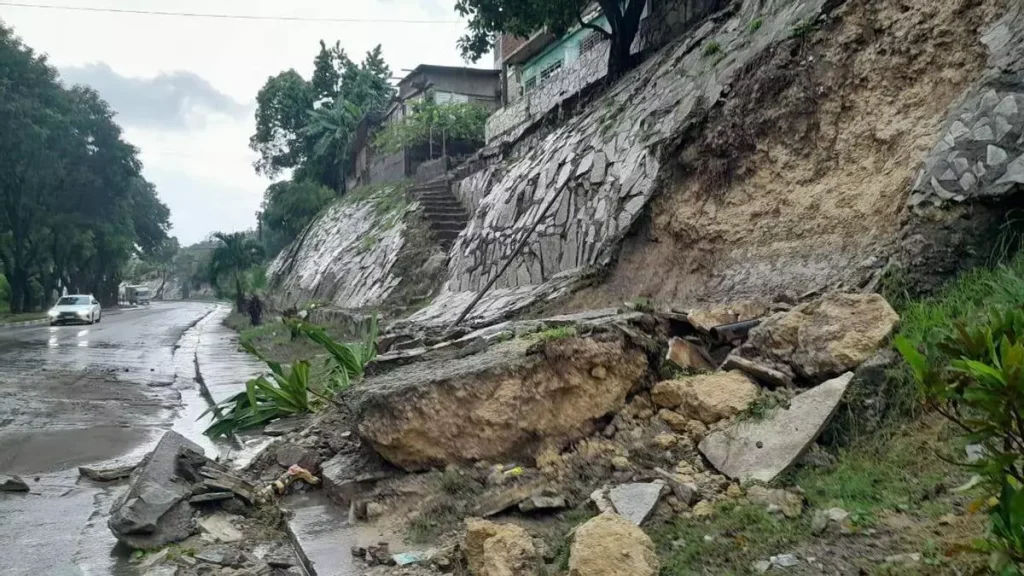Classes are suspended in Santiago de Cuba and Guantánamo this Monday, when lighter rains are expected

![]() 14ymedio, Madrid, September 29, 2025 — The intense rains that tropical storm Imelda left in Santiago de Cuba have resulted in one fatality: Luis Mario Pérez Coiterio, a 60-year-old man whose house collapsed early in the morning while he was sleeping, due to a landslide.
14ymedio, Madrid, September 29, 2025 — The intense rains that tropical storm Imelda left in Santiago de Cuba have resulted in one fatality: Luis Mario Pérez Coiterio, a 60-year-old man whose house collapsed early in the morning while he was sleeping, due to a landslide.
The house was located on a hillside of the Veguita de Galo division, in Santiago de Cuba, and according to the official version published by TV Santiago, it was not a suitable place to live. “Close relatives present at the site informed the authorities that while he was living with them, Luis Mario was happy and had a safe home but unfortunately decided to return. They even asked him to stay with them during the storm because his home wasn’t safe,” said the report.
From the hundreds of comments that followed the publication, it is clear that the deceased was a vulnerable person. “What painful news. Great person, he was my neighbor. A person who because of his physical situation was able to go out day by day to fight like a warrior, selling mops, brooms, look for wood to cook his food, how sad. Rest in peace, my friend. May God hold you in glory, fly very high,” wrote one user.
The official information highlighted that the body was recovered by rescue teams, but the deceased’s sister posted several messages in the comments thanking everyone for the condolences but asking to tell “the truth” and denying that Beatriz Johnson Urrutia, first Party secretary in the province, was present on the spot. “From 1:00 am my brother was under the rubble, and a neighbor warned us at 1:00 pm. My eldest son along with neighbors took him out; before the firefighters arrived they had already taken him out,” said Nivia Pérez, who also pointed out that her brother was not married, contrary to what the publication claimed.
“Don’t write lies, respect the pain of others. My brother lived alone in that house in bad condition,” she said.
A neighbor also referred to the insecurity of the area. “My mom has a ceiba tree next to her house; these rains knocked down a wall and nobody does anything. As much as the need for pruning was reported, they didn’t say anything except that have no gas or no crane that can get there. It’s always something. And the life and integrity of the home is at risk. It rains inside the house because a wall has collapsed and is open, and the ceiba stands as the new wall, and in Santiago there is no one to respond. They wait for the worst to happen to act,” she lamented.
The force of the rain has also caused significant structural damage to the Cañizo bridge in the municipality of Guamá. “The weather phenomenon undermined one of the corners of the infrastructure, leaving exposed the concrete base that supports the passage.”
“Currently, the only visible and functional part of the bridge is the top slab, which poses a potential risk to vehicles and pedestrians. Any additional weight on the structure could compromise its stability, so extreme caution is required when transiting through the area,” official sources have noted.
The Cañizo bridge connects several rural communities with the center of the municipality and is used daily by residents, trucks and basic services, the report indicates. However, the road has not been completely cut off, although there are calls for “traffic limitations and safety measures to prevent accidents.”
Another damaged infrastructure has been the already weakened electricity grid. The provincial manager, Javier Calero Román, indicated that there are fallen poles and faults in distribution lines, especially in the area of Guamá and the capital city of Santiago. The general manager of the Provincial Electric Company stated that the main incidents are due to fallen poles and the deterioration of distribution lines.
“We are giving priority to circuits that feed vital centers such as hospitals, pumping stations and areas of high population concentration. Coordination with the Provincial Temporary Working Group has been key to organizing response actions and ensuring access to affected areas,” said Calero Román. The damage is not great, he says, but recovery also depends on how the storm develops.
Imelda has left more than 18,000 evacuees in Guantánamo. According to the latest report of the Institute of Meteorology (INSMET), it is expected that the rains will continue to be strong, at least in the south and the mountainous areas of the east. The center may suffer some showers, while in the western area, which will be cloudy, isolated rains are expected.
Given the current situation, local authorities have suspended classes at all levels of education in Santiago and Guantanámo, although childcare centers will be open.
The hydraulic company of Santiago de Cuba said that 8.2 million cubic meters [2,166.2 million liquid gallons] have currently been collected in the province’s 16 reservoirs, which until now suffered from a long drought.
Translated by Regina Anavy
____________
COLLABORATE WITH OUR WORK: The 14ymedio team is committed to practicing serious journalism that reflects Cuba’s reality in all its depth. Thank you for joining us on this long journey. We invite you to continue supporting us by becoming a member of 14ymedio now. Together we can continue transforming journalism in Cuba.
